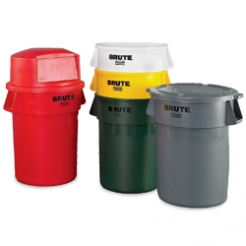 Garbage cans periodically need to be cleaned. How often they must be cleaned depends on a lot of factors, such as what type of trash they collect, how often they fill up, and even what time of the year it is.
Garbage cans periodically need to be cleaned. How often they must be cleaned depends on a lot of factors, such as what type of trash they collect, how often they fill up, and even what time of the year it is.
Any garbage can that collects damp, moist trash — such as food waste or chemical products — should be cleaned regularly, especially in warmer weather. That’s because flies need heat and moisture in order to lay their eggs. So a garbage that isn’t cleaned frequently in the summer can easily lead to maggots.
Proper Techniques for Cleaning Garbage Cans
Both small and large trash cans should be cleaned on a regular basis. Generally, once per week in the summer months and once per month in the winter months is a good rule of thumb.
Move the garbage can to an area with drainage, such as outdoors or in a garage with a sewer drain. Next, squirt a little dishwashing liquid into the bottom of the garbage can. Most commercial dish soaps contain phosphates that will help loosen built-up dirt and stains on the inside of the garbage can, as well as perfumes and sanitizers to help mask the odor.
Then use a sprayer attached to a hose to rinse out the interior of the garbage can. Tilt the garbage can over to let the water run out into the drain.
Turn the garbage can upright to rinse it again, then drain it again. Repeat if necessary.
Helpful Tips for Cleaning Garbage Cans
To kill maggots, mix a mild bleach solution in a bucket then pour it into the garbage can and swish it around. Wear rubber gloves to protect your hands and be careful not to splash the bleach solution on your clothing because it will stain.
Don’t use bleach of there’s a possibility it might react with other chemicals that may have pooled in the garbage can.
It’s easier to clean several garbage cans at once rather than doing one at a time. But you probably don’t want to clean all of your business’s garbage cans at the same time because that will leave no place for people to throw their garbage.
If possible, in warmer weather turn the garbage cans upside down and let them air dry completely before returning them to use. In freezing weather or if there’s no time for drying, turn them upside down and gently bang them against the ground to get as much liquid out as possible before bringing them back where they usually go.
